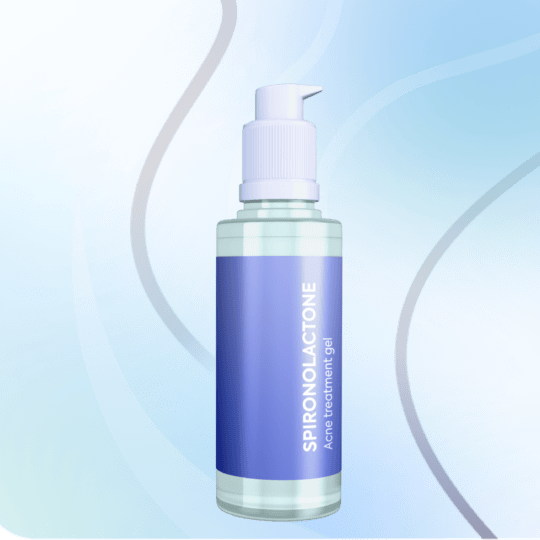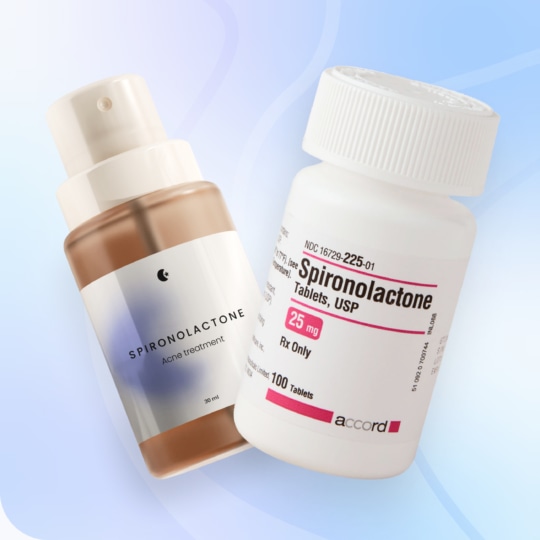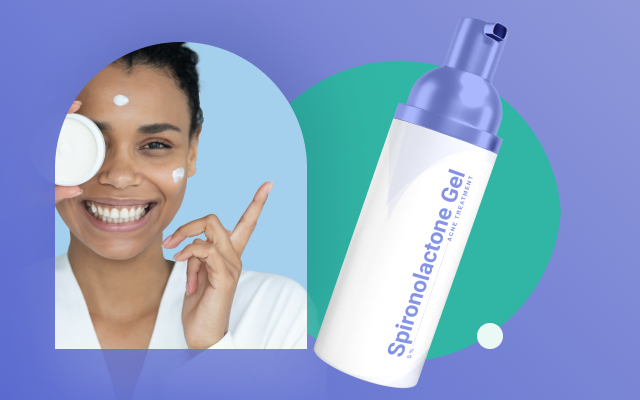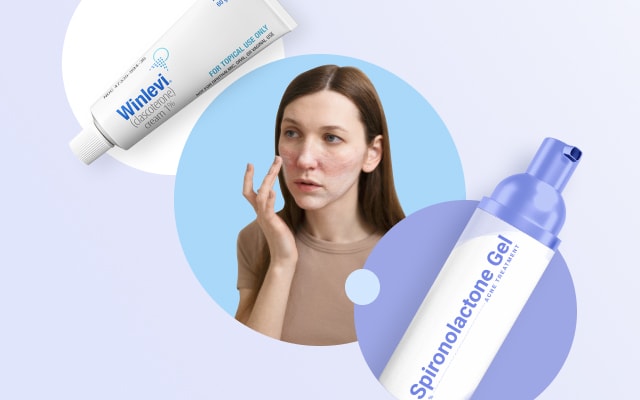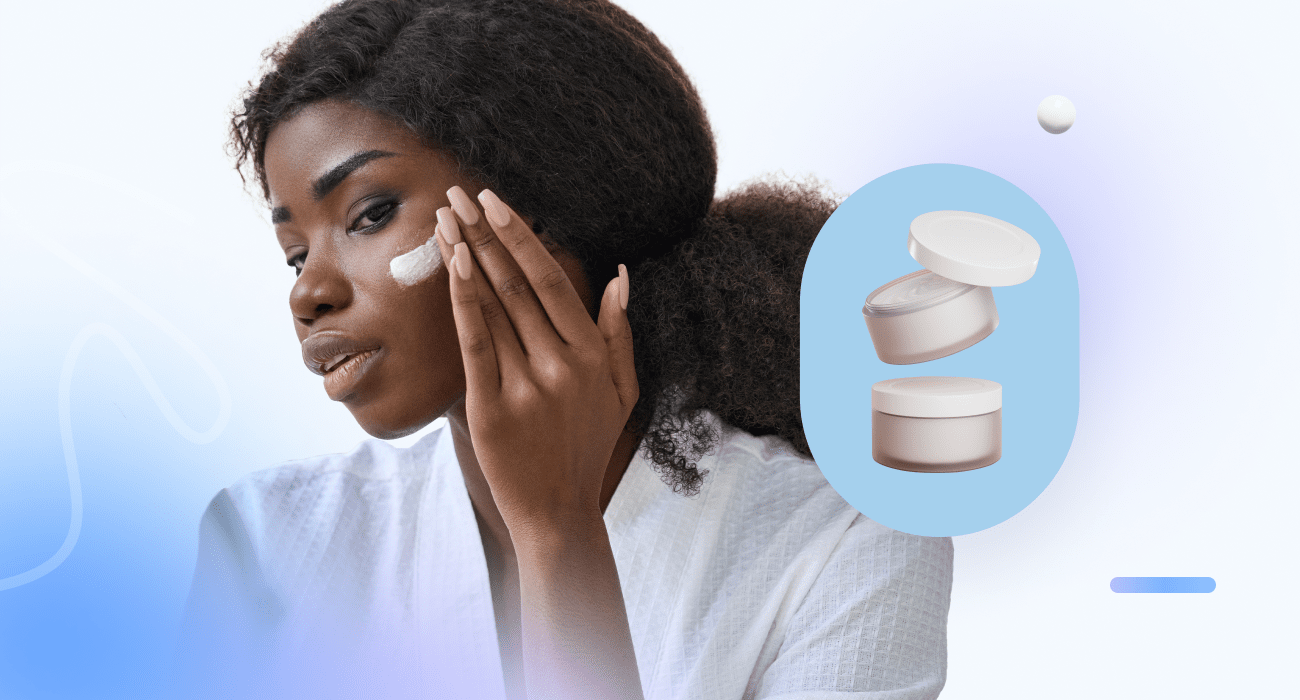How long does it take for spironolactone to work?
Dr. Patrick Mahar, dermatologist, talks about how spironolactone is used off-label for the treatment of acne for women, what is the right dose, and how long does it take?
Table of Content:
What is spironolactone? | How to get a prescription? | How does spironolactone work for acne? | How long does spironolactone take to work? | What is the recommended dose for acne? | Advantages | Side-effects | Formulations | Brands | Can you use it long term? | Interactions
Our commitment to producing high-quality content:
The information presented in this article is based on scientific research and the professional advice of our Content Medical Reviewers, who are experts in the field of Dermatology. How we write our content →
What is spironolactone?
Dr. Patrick Mahar, dermatologist, says that spironolactone is a potassium-sparing diuretic (water pill) initially developed to treat conditions such as heart failure and high blood pressure1 but it is nowadays used off-label for various medical purposes such as:
- Hormonal acne in women
- Excessive hair growth (hirsutism)
- Excessive production of aldosterone
- Abnormal accumulation of fluid in body tissues, leading to swelling or edema
- Very low levels of potassium (hypokalemia)2
- Hair loss in women3
It is important to note that spironolactone is not appropriate for men or women who are pregnant or breastfeeding women unless there are specific circumstances, and it is prescribed to you by your doctor.
Do I need a prescription to get spironolactone for acne?
Yes, oral spironolactone and topical spironolactone can only be purchased with a doctor’s prescription.
How can I get an online prescription of oral spironolactone?
You can get a spironolactone prescription for hair acne by having a photo consultation with an virtual dermatology provider. This only costs $59 and you will get your prescription (if medically adequate for you) in 1-2 working days.
How does spironolactone work for acne?
Spironolactone (Aldactone) is a diuretic (water pill) used to treat female acne as hormone therapy by targeting the hormonal aspect of the disease5.
Dr. Mahar says that spironolactone slows down the body’s production of skin oil (sebum) by preventing a hormone called dihydrotestosterone (DHT) from attaching to specific receptors.
Spironolactone does not show results as quickly as other treatment options6 7 .
How long does spironolactone take to work for acne?
Dr. Mahar says that spironolactone is not as fast working as other prescription medications, so depending on your skin, you should see improvements after 8 to 12 weeks.
Studies show that many women experience high success rates and that improvement ranges from a 50% to 100% reduction in their face and body acne after week 12 .
What is the recommended dose of spironolactone for acne?
According to Dr. Patrick Mahar, the typical spironolactone dose recommended for acne patients varies from 50 to 200 mg per day.
What is the maximum/highest dose of spironolactone for acne?
Dr. Mahar says the maximum recommended dose of spironolactone for acne is 200 mg per day.
What is the lowest dose of spironolactone for acne?
Dr. Mahar says the lowest dose of spironolactone for acne is usually 50 mg per day.
Is 25 mg of spironolactone enough for acne?
Dr. Mahar says that in some cases, a 25 mg dose of spironolactone may be sufficient to treat acne, but typically the starting dose is usually 50 mg. If this isn’t effective, the dose may be gradually increased by a healthcare provider. The goal is to find the lowest effective dose with minimal side effects, so regular follow-ups are important.
Is 50 mg of spironolactone enough for acne?
Dr. Mahar says that usually 50 mg of spironolactone is usually the starting dose for acne and the dose may be gradually increased up to 200 mg depending on how the patient reacts to the medicine.
Is 200 mg of spironolactone too much for acne?
Dr. Mahar says that 200 mg of spironolactone is usually the highest dose used in the treatment of acne, this means that you doctor will probably get you started with a lower dose and gradually increase it up to 200 mg if the patient responds well to the medicine and the treatments is considered effective.
What happens if I miss a dose of spironolactone for acne?
Dr. Mahar recommends that If you miss a dose of spironolactone, take it as soon as possible. However, if it is almost time for your next dose, skip the missed dose and do not take a double dose.
What happens if I take a double dose of spironolactone?
Dr. Mahar says that in most cases, if you accidentally take an extra dose of spironolactone, you are likely to be alright. However, there may be a small chance that your blood pressure might drop too low. It is important to get in touch with your doctor if you start feeling unwell and if you have kidney or liver disease.
Your doctor will probably ask you to check your blood pressure at home and keep an eye out for symptoms such as nausea, dizziness, or drowsiness throughout the day.
If you experience these symptoms, call your doctor.
Advantages of using oral spironolactone for acne
Traditional acne prescription medication such as oral antibiotics and isotretinoin are usually recommended for three to six months, respectively. The long-term use of antibiotics can contribute to bacterial resistance and the use of isotretinoin can cause multiple side-effects, some of which can be serious.
Oral and topical spironolactone have the advantage that may be used long term. Studies have also shown spironolactone is effective at treating acne with improvement ranging from a 50% to 100% reduction of acne breakouts4.
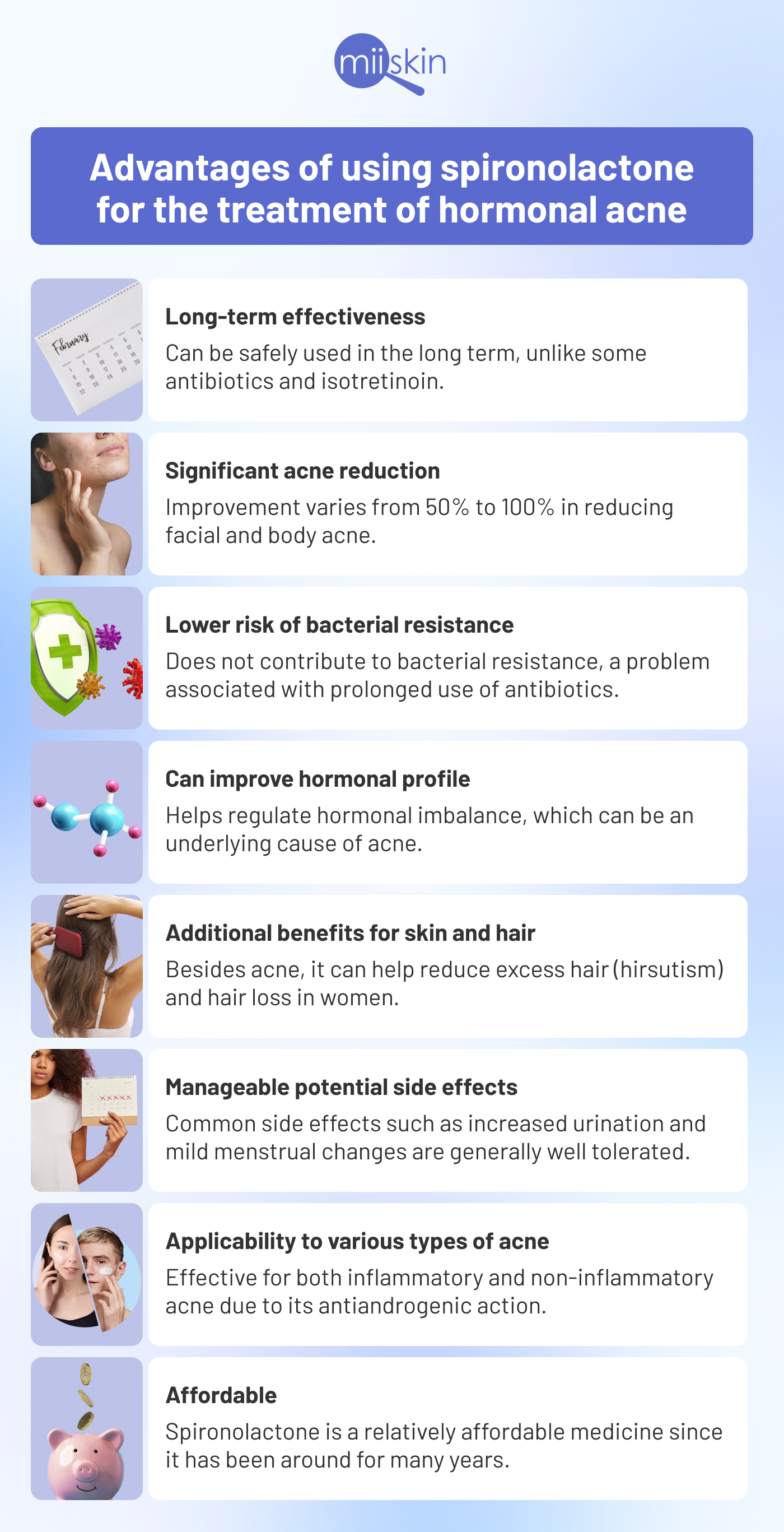
Potential side effects of oral spironolactone
Spironolactone may cause more side effects than the ones mentioned on this list, this is just a summary of the most common side effects.
- Increase in urination
- Headaches
- Frequent bowel movements
- Menstrual disorders
- Breast tenderness
- Fatigue
- Dizziness
- Low blood pressure
- Elevated blood-potassium
- Decreased sex drive8
Spironolactone formulations
Spironolactone comes in three different formulations: tablets, suspension and topical.
- Spironolactone (Aldactone) tablets are available in 25mg, 50mg, 100mg
- Carospir suspension 25mg/5ml
Spironolactone brands
- Aldactone
- Carospir
Need Expert Dermatologist Care?

Get expert advice from a licensed online dermatologist by simply uploading photos from your phone. If needed, a prescription (branded or generic depending on preference) will be sent directly to your favorite pharmacy. Nationwide coverage.
When to take spironolactone?
Dr. Mahar says that you will usually take spironolactone in the morning. If you have been prescribed by your doctor a higher dose, you might need to take it twice a day. If this is the case try to make sure you take the second dose no later than 4:00 pm.
If you take spironolactone at night, you may need to go to the bathroom a few times during the night.
Can you use spironolactone long term?
Dr. Mahar says that you can safely take spironolactone long term, together with an effective contraception method. Your healthcare provider will probably suggest having occasional blood tests to make sure your potassium levels are properly balanced, and your blood pressure is not too low.
Other acne treatments for acne such as minocycline, doxycycline, Seysara and isotretinoin, should not be used long-term.
Can you use spironolactone while trying to conceive?
Dr. Mahar says that spironolactone should not be taken while you are pregnant, trying to conceive or breastfeeding as it may cause birth defects.
How much water should i drink when taking spironolactone?
Dr. Mahar says that when you are taking spironolactone, it’s important to stay adequately hydrated, generally aiming for around 8 glasses (2 liters) of water daily, though this can vary based on individual needs. Since spironolactone is a diuretic, balancing hydration is crucial. You should avoid both dehydration and overhydration to maintain proper electrolyte levels, particularly potassium. Monitoring your urine color (pale yellow is ideal) can help gauge hydration. Always follow your healthcare provider’s advice, especially if you have conditions like kidney or heart issues, and watch for signs of dehydration or overhydration.
Common spironolactone interactions
Spironolactone has over 100 drug interactions. Please tell your online dermatologist if you are taking any medicines or supplements.
Alcohol and spironolactone
If you’re using spironolactone for acne, a mild alcohol consumption is generally permissible. Nevertheless, follow the suggested recommendations of having a maximum of 2 alcohol units daily and 14 units per week.
As a guidance, a regular 175ml glass of wine constitutes 2 units, while a pint of beer usually contains 2 to 3 units of alcohol.
Ibuprofen and spironolactone
Spironolactone has many drug interactions which include common painkillers such as ibuprofen, diclofenac, naproxen or aspirin. You should not take these medications unless instructed by your doctor to do so.
Spironolactone and Adderall
Adderall is a stimulant commonly used to treat attention deficit hyperactivity disorder (ADHD) and It can increase heart rate and blood pressure. On the other hand, spironolactone lowers blood pressure. Taking these medications together could potentially lead to unpredictable changes in blood pressure, which might be harmful. You should let your doctor know if you are taking Adderall before they prescribe oral spironolactone.
Spironolactone and magnesium
Both magnesium and spironolactone can affect the balance of electrolytes in your body, particularly potassium . If you have been prescribed spironolactone it may be best to skip the magnesium supplements at least while you are taking the medication.
Spironolactone and lithium
Spironolactone and lithium may have similar effects on the body when it comes to inhibiting a hormone called aldosterone, therefore taking them both at the same time is not recommended.
Spironolactone and Zoloft (sertraline)
Spironolactone and Zoloft (sertraline) can both lower blood pressure, therefore they should not be taken at the same time unless advised for your doctor.
Spironolactone and tretinoin
In recent years, there has been growing attention on the concurrent use of tretinoin and spironolactone for addressing hormonal acne. Our comprehensive article, ‘Exploring Tretinoin and Spironolactone for Hormonal Acne Treatment,’ delves into the separate mechanisms of action and scientific evidence supporting their combined application. By incorporating findings from relevant clinical studies, we aim to provide a thorough understanding of this potent acne-fighting combination.
Lee el articulo en Español Espironolactona ¿Para qué sirve?
Key article points
- Spironolactone Overview: Spironolactone is a potassium-sparing diuretic initially developed for treating heart failure and high blood pressure, now commonly used off-label for conditions like hormonal acne, hirsutism, and hair loss in women.
- Advantages for Acne Treatment: Spironolactone is effective in reducing acne breakouts by 50% to 100% and can be used long-term without contributing to bacterial resistance, unlike antibiotics.
- How It Works for Acne: Spironolactone targets the hormonal causes of acne by preventing dihydrotestosterone (DHT) from binding to receptors, reducing sebum production and subsequently acne.
- Potential Side Effects: Common side effects of spironolactone include increased urination, headaches, menstrual disorders, breast tenderness, dizziness, and low blood pressure.
- Dosage and Long-Term Use: The typical starting dose for acne is 50 mg per day, which can be increased up to 200 mg if needed. Spironolactone is safe for long-term use with regular monitoring of potassium levels and blood pressure.
Do you need a spironolactone prescription?
Article References:
https://www.mayoclinic.org/drugs-supplements/spironolactone-oral-route/side-effects/drg-20071534?p=1
https://reference.medscape.com/drug/carospir-aldactone-spironolactone-342407
https://www.ncbi.nlm.nih.gov/pmc/articles/PMC10010138/
https://www.dermatologytimes.com/view/spironolactone-safe-and-effective-adult-female-acne
https://www.ncbi.nlm.nih.gov/books/NBK554421/
https://www.ncbi.nlm.nih.gov/pmc/articles/PMC5440451/
https://my.clevelandclinic.org/health/drugs/19755-spironolactone-tablets
https://www.dermatologytimes.com/view/spironolactone-safe-and-effective-adult-female-acne
https://www.bmj.com/content/381/bmj-2022-074349
https://www.aad.org/public/diseases/acne/derm-treat/hormonal-therapy
https://www.mayoclinic.org/drugs-supplements/spironolactone-oral-route/side-effects/drg-20071534?p=1
https://www.nhs.uk/medicines/spironolactone/common-questions-about-spironolactone/
https://www.ncbi.nlm.nih.gov/books/NBK556103/
https://my.clevelandclinic.org/health/diseases/23264-hypomagnesemia
https://pubmed.ncbi.nlm.nih.gov/670960/
https://pubmed.ncbi.nlm.nih.gov/29042710/


